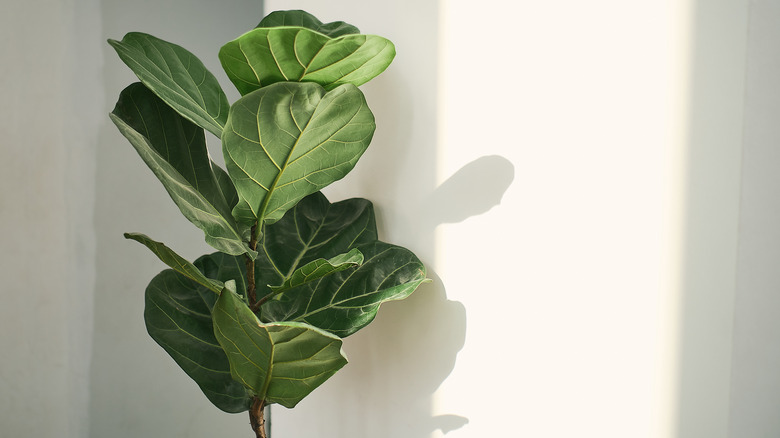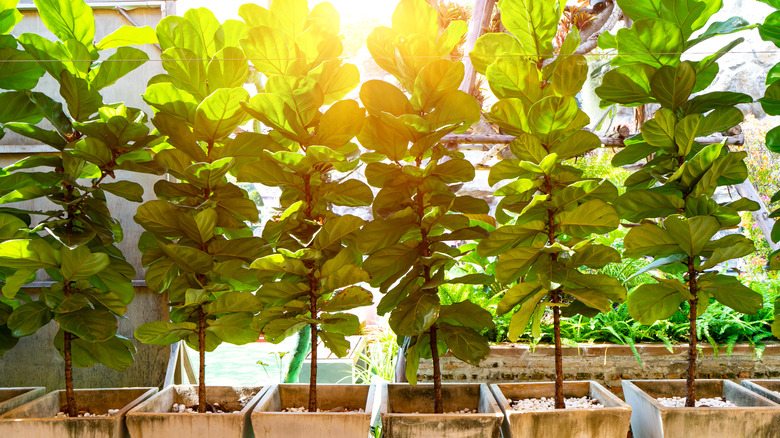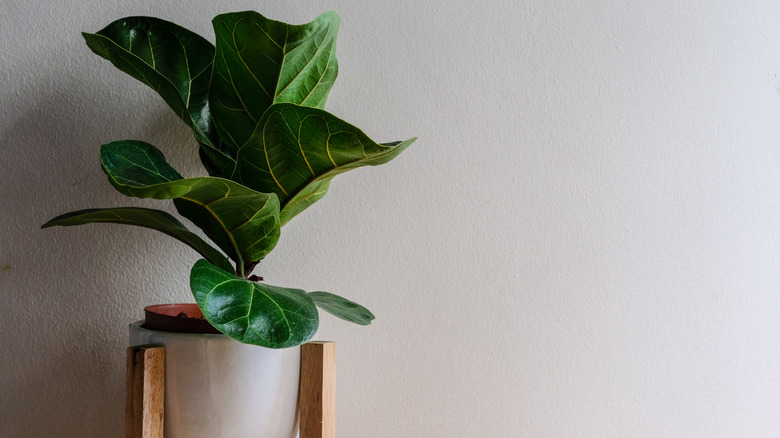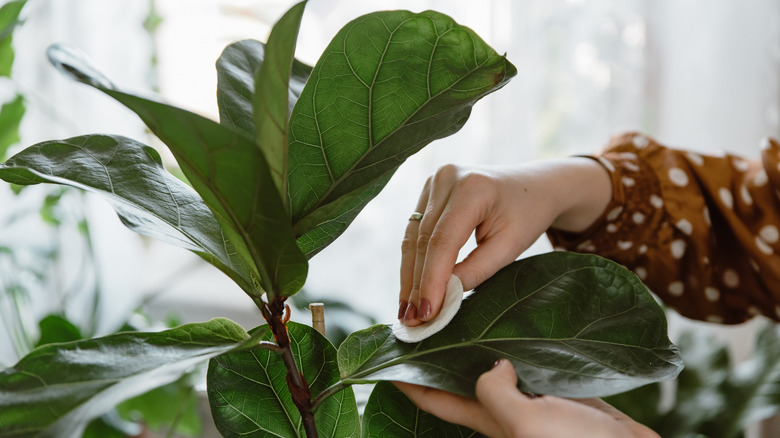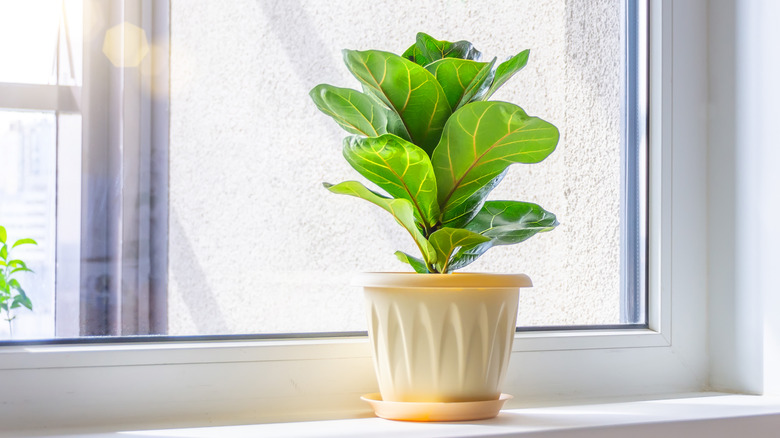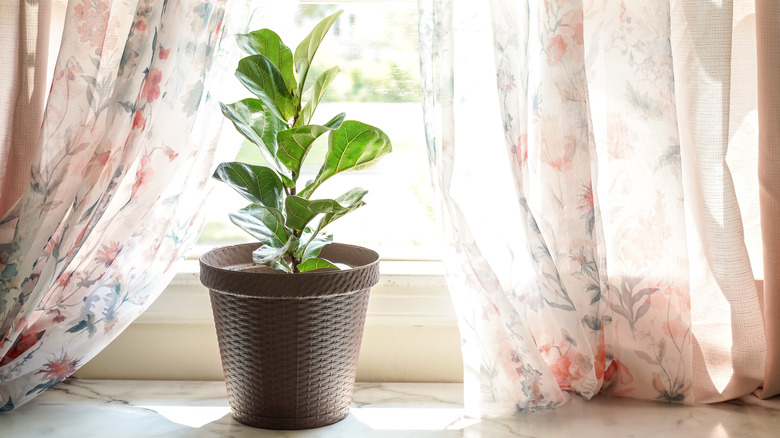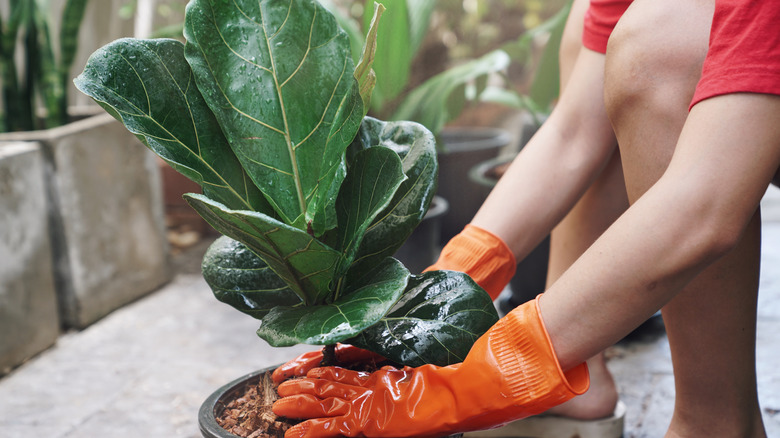How To Properly Take Care Of A Fiddle Leaf Fig Plant
Fiddle leaf figs, or ficus lyrata, are an incredibly popular houseplant. Native to West and Central Africa, the plant can grow up to 10 feet tall, according to The Spruce, and makes for an excellent statement houseplant. Fiddle Leaf Fig Plant says the plant can live anywhere from 25 to 50 years or longer when properly maintained, making their care a long-term, rewarding investment.
The plant gets its common name from its large fronds, which resemble a fiddle or violin. The waxy leaves can grow up to 30 inches and feature deep veins. When kept outdoors, the plant can produce flowers and inedible fruit, though very few places in the U.S. are conducive to growing it outside. They are also naturally pollinated by wasps.
This plant is very popular in the houseplant community. It presents many advanced houseplant experts with a challenge to keep it as happy as possible, though it is a relatively hardy plant and can withstand some trial and error.
How to use fiddle leaf fig in garden
Fiddle leaf figs are not usually grown outdoors in the U.S. They are native to tropical climates, and require lots of heat and humidity to thrive outside. That being said, the plant can be sustained in USDA hardiness zones 10-12, which includes South Florida, Southern California, and Hawaii, according to South Florida Plant Guide. When planting the tree outside, understand that it grows to extraordinary sizes — up to 50 feet tall and more than 3 feet thick, per Gardening Know How.
The plant needs to be located in a sunny position and is also sensitive to wind damage. Make sure it's out of the way of strong cross breezes, and consider adding other plants or structures for additional gust protection. Frequent pruning will also prevent large branches from snapping off and causing injury to the plant and others.
South Florida Plant Guide also has suggestions for how to use the plant in landscaping, including featuring it as a shade tree or otherwise accenting the yard. As for companion plants, they recommend dwarf powderpuffs, crotons, gardenias, star jasmines, blue porterweeds, and blackberry irises.
How to grow fiddle leaf fig
As stated earlier, fiddle leaf fig trees are incredibly popular. Due to this popularity, however, they can be hard to find at your local garden center. Its popularity combined with its size also causes it to be quite pricey. An easy fix for that is propagating the leaves of an existing plant, which can be obtained from your own plant, a friend, or purchased online.
Fiddle leaf figs are propagated by stem cuttings. To obtain a stem cutting, start by assessing a tall branch of the plant. Cut off a 12- to 18-inch stem, and ensure it has at least two to three nodes (the little bud notches along the plant where new leaves grow). Remove all but the top few leaves of the plant, so that it won't have to work to maintain the extra foliage, according to A Piece of Rainbow.
From here, you can propagate in either soil or water. To propagate in soil, dip the cut end of the stem in rooting hormone. Fill a pot large enough to support the weight of the cutting with soil, and add the cutting. To keep things moist, consider covering it with a plastic bag. For starting in water, simply fill a vessel with water, add a pump or two of liquid fertilizer, and place the cutting inside. Change the water when it gets cloudy. Expect roots to form within a month or two, and transplant when they're a couple inches long.
How to care for fiddle leaf fig
Fiddle leaf figs aren't necessarily hard to care for, but they do have more specific and demanding needs than other plants, and they become visibly unhappy much quicker. In general, you should aim to mimic its native growing conditions. Indoor fiddle leaf figs will prefer plenty of bright, but indirect light, according to Bloomscape. East and western facing windows are excellent options, as long as the plant is out of the direct morning and evening rays. South-facing windows are also a good choice, as long as the plant is out of direct beams, but avoid north-facing windows. Regarding watering, you'll want to wait until the plant is nearly totally dry (about 75%, Bloomscape recommends), and then water very thoroughly. Allow any excess water to drain out.
It's key to provide fiddle leaf figs with plenty of humidity. They will generally benefit from daily misting, or more often in dryer areas. Consider placing a humidifier by the plant, or utilizing a pebble tray. Fertilize monthly in the spring and summer with a simple houseplant fertilizer.
Since fiddle leaf fig plants have such large leaves, they tend to accumulate a lot of dust. Gently wipe down the large leaves with water once a week. It can also benefit from occasional shaking, says Gardeningetc, since it mimics natural wind and rainstorms. Every now and then, grip the trunk and give the plant a gentle but firm shaking. This will help strengthen the plant.
Fiddle leaf fig varieties
Fiddle leaf fig trees are the most popular of the ficus lyrata cultivars. There are a few other varieties, though they are rarer. If these varieties are of interest to you, your best bet is looking for online sellers instead of your local garden center, though be warned, it will cost you significantly more. Here are the three other ficus lyrata cultivars, per Garden Design:
-
Ficus lyrata 'Variegata': This dramatic variety is one of the rarest and most expensive and is identifiable by the creamy, off-white border and leaf variegations.
-
Ficus lyrata 'Compacta': This variety is a little shorter than the regular fiddle leaf, only growing to 5 feet tall, and is unique for its leaves which only grow to half the size of the common variety.
-
Ficus lyrata 'Bambino': This ficus lyrata is a dwarf variety, only reaching 30 inches in height and is conveniently much cheaper than the common fiddle leaf fig tree.
Are fiddle leaf figs toxic?
If you're itching to get your hands on this trendy plant, pause and consider your pets. The plant is, sadly, toxic to some animals, Fiddle Leaf Fig Plant warns. It secretes a sap high in calcium oxalate crystals which, while not necessarily fatal to cats and dogs, should be avoided. Poisoning symptoms in pets include oral swelling, excessive salivation, vomiting, loss of appetite, diarrhea, increased thirst, and frequent urination. Dogs specifically will paw at their mouth, and cats will become dehydrated and either drink more water than usual, or none at all. If you suspect your pet has eaten the plant, call the vet immediately. If your vet recommends bringing your pet in, take a picture of the plant or the eaten leaf, so they can determine how severe the poisoning is.
The calcium oxalate crystals in the plant are also mildly toxic to humans. In adults, the most common source of this irritant is the sap. Touching it will result in mild to severe skin irritation, which will go away on its own if you wash your hands thoroughly. Wear gloves when handling the plant to avoid this. Curious children may get into the plant, though, so keep it somewhere beyond their reach.
How to repot fiddle leaf fig
According to HGTV, fiddle leaf figs should be repotted about every two years. Some signs to look out for are evidence of roots growing out of the drainage holes or soil surface, or if the plant generally looks too big in its current pot. When searching for a new pot or planter, look for one about 2 inches larger than its current home.
As for materials, look for small drainage rocks and a well-draining, moisture control potting soil. Drainage rocks should be small and jagged and can be found at most stores. Lay an inch or two of the stones at the bottom of the pot, as they will help encourage proper levels of drainage and moisture retention. Then, add some soil to the pot. Remove your plant from its current pot, and assess the root ball, cutting off any rotten or mushy roots. Using the size of the root ball as your guide, make a hole in the soil big enough for the plant. Add the plant in, and fill the pot with soil. Water thoroughly to expose air pockets, fill with soil, and repeat. If your plant is especially top-heavy, you add a stake at this point for additional support.
